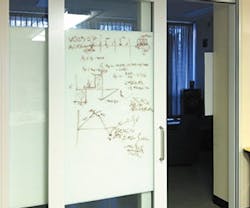Put Your Walls to Work
Are the walls in your facility simply barriers and separators? If so, they could be obstructing more than just space. They could be impeding how that space is used.
The features of modular wall systems allow for more than just repurposing the framework of workstations and offices. New offerings can impact the functionality of a workplace as well.
Discover the following features so you can maximize the usability of your real estate, accommodate different work styles, and future-proof your facility.
Foster Functionality
“Other than the definition of space, one opportunity you have with big architectural elements like walls is maximizing how you can use that space,” says Shawn Green, vice president of design for manufacturer KI. “The cost of real estate is still very expensive, so being able to interject better, more effective space division – making the office smaller yet providing occupants more usable work or wall space – is huge.”
Some ways that wall solutions are improving functionality is by incorporating writable surfaces, tack boards, and sliding doors.
“With these features, the user doesn’t feel like they’re downgrading,” Green explains. “They may be going to a smaller space, but they’re actually enhancing their experience.”
Other offerings can have work surfaces, small shelves, or computer monitor arms hung directly from the wall.
“These items either determine or support the purpose of a room,” explains Kris Yates, vice president of architectural walls for manufacturer Allsteel. “Privacy panels can be used in executive offices, or writable and tackable surfaces can spur collaboration in meetings or conference rooms.”
The opacity of certain glass wall solutions can be changed by the user, providing a projection surface. “This removes the need for a screen or other equipment and maximizes your usable space,” says Donald Press, general manager of architecture and design for manufacturer SCHOTT, adding that the feature is popular in offices, education, and healthcare.
Healthcare-specific applications also present unique opportunities. Certain systems can support diagnostic equipment, sinks, and medical casework. Some even offer foldout Murphy beds.
“The wall cavity can just be a cartridge for actually housing things in the wall,” explains Kristin Moore, director of healthcare at manufacturer DIRTT. “Wall systems can be flexible platforms for whatever has to be done in the space.”
Try Technology
Running power to components is simple in modular wall systems, says Green.
“It looks great to hang a flat screen TV on the wall, but getting cable and electricity behind it is complicated,” he says. “These products have flexibility so if you need to change the way power is routed or distributed, you can do that without disturbing the wall and without all the drywall dust and downtime.”
Lighting is also being integrated into some offerings to either emphasize corridors and hallways or enhance aesthetics, says Green.
“Colored LEDs are becoming popular in lobbies, retail, and any hospitality environment,” adds Press.
Semi-transparent, mirrored glass is being combined with monitors to enhance the customer experience in retail applications, Press says. Similar reflective glass is used in two-way mirrors at police stations and courthouses, but when placed in front of a touch screen, the technology has found new applications.
“A customer can go to a mirror with an item, and the monitor behind this glass can read the tag, change from a mirror to a screen, and then display the item on a model or allow the customer to touch-select a different size that is brought to them,” Press says. “The glass is also being used in offices to turn your wall into an interior iPad or tablet.”
Aid Adaptability
As office floor plans change to facilitate more collaboration, the vertical surface must adapt likewise. Having walls that can accommodate impromptu meetings using these features is a key element in attracting and retaining occupants.
“Planning for change is essential,” says Green. “In commercial real estate, we think ardently about lend/lease spaces that are designed to suit a particular customer. But when you can flip the space around based on changing need sets, and without having to use complex trades like carpenters and electricians, that’s powerful.”
Focus less on the limitations of space and more on how you can use it to improve occupant experience.
“Walls don’t have to be a fixed element – they can be flexible,” says Yates. “With these features, they can support work and rapid change.”
As technology and work styles continually transform, the workplace should be future-proofed in order to keep up with the changes.
“No one knows what the future will looks like, so instead of trying to guess at it or responding retroactively, try to create an agile environment that can react to whatever comes down the pipeline,” says Moore. “Don’t treat interiors like a disposable element where if something doesn’t work, the only option is to tear it out, throw it away, and start all over again.”
Chris Curtland [email protected] is assistant editor of BUILDINGS.
